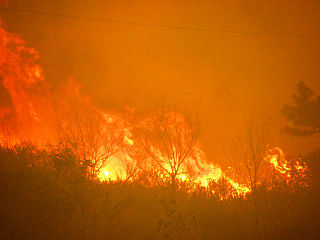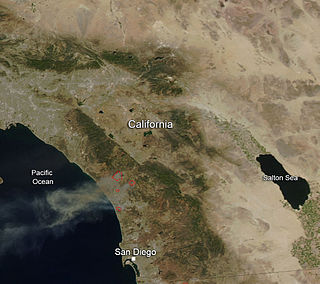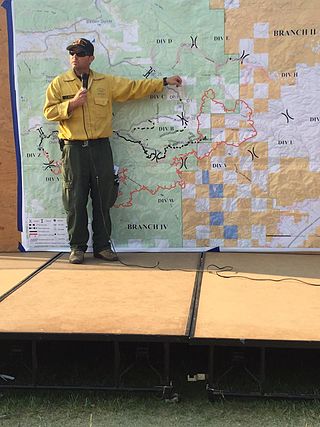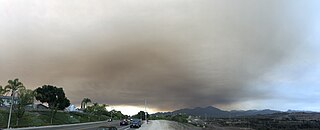
La Veta is a statutory town in Huerfano County, Colorado, United States. La Veta sits at the base of the Spanish Peaks on the Highway of Legends National Scenic Byway. The town population was 862 as of the 2020 United States Census.

Fourmile Canyon or Four Mile Canyon is a mountainous canyon in western Boulder County, Colorado that channels a stream known as Fourmile Creek or Four Mile Creek .). The stream rises at 40.048°N 105.550°W on the southern slope of Niwot Mountain, before flowing east and south through the unincorporated communities of Sunset, Wallstreet, Salina and Crisman to the confluence with Boulder Creek at 40.015°N 105.324°W in Boulder Canyon, four miles west of the historic location of the Boulder Railroad Depot.

The Waldo Canyon fire was a forest fire that started approximately 4 miles (6.4 km) northwest of Colorado Springs, Colorado on June 23, 2012, and was declared 100 percent contained on July 10, 2012, after no smoke plumes were visible on a small portion of the containment line on Blodgett Peak. The fire was active in the Pike National Forest and adjoining areas, covering a total of 18,247 acres. The fire had caused the evacuation of over 32,000 residents of Colorado Springs, Manitou Springs and Woodland Park, several small mountain communities along the southwestern side of U.S. Highway 24, and partial evacuation of the United States Air Force Academy. There were 346 homes destroyed by the fire. U.S. Highway 24, a major east–west road, was closed in both directions. The Waldo Canyon Fire resulted in insurance claims totaling more than US $453.7 million. It was the most destructive fire in Colorado state history, as measured by the number of homes destroyed, until the Black Forest Fire surpassed it almost a year later when it consumed 486 homes and damaged 28 others.

The 2012 Colorado wildfires were an unusually devastating series of Colorado wildfires, including several separate fires that occurred throughout June, July, and August 2012. At least 34,500 residents were evacuated in June.

The Black Forest Fire was a forest fire that began near Highway 83 and Shoup Road in Black Forest, Colorado around 1:00 p.m. on June 11, 2013. As of June 20, 2013, the fire was 100 percent contained, 14,280 acres were burned, at least 509 homes were said to be destroyed, and two people had died. This was the most destructive fire in the state's history at the time, surpassing the 2012 Waldo Canyon Fire which also began near Colorado Springs. It was surpassed in 2021, when the Marshall Fire destroyed over 1,000 homes in Boulder County, in Superior and Louisville.

In the summer of 2013, there were several major wildfires in Colorado in the United States. During June and July, record high temperatures and dry conditions fueled the fires all across the state. By July 24, 570 structures had been destroyed and 2 people died. Below is a list of the major fires of the year.

2014 saw several notable wildfires igniting in California, especially during the month of May, when multiple fires were ablaze concurrently in Southern California, and during September, when several massive wildfires were burning in Northern California. In the context of the 2012–13 North American drought, as well as powerful Santa Ana winds, weather conditions were ideal for wildfires. A total of 7,865 wildfires ignited throughout the year, which burned at least 625,540 acres (2,531.5 km2) of land. The wildfires caused a total of 146 injuries and 2 fatalities, in addition to causing at least $204.05 million in damage.

The May 2014 San Diego County wildfires were a swarm of 20 wildfires that erupted during May 2014, in San Diego County, California, during severe Santa Ana Wind conditions, historic drought conditions, and a heat wave. The main event during mid-May was preceded by a precursor fire that ignited on May 5. The Bernardo Fire has been declared accidental, and officials believe the Cocos Fire was intentionally set. The causes of the other fires are still under investigation by multiple agencies, and a joint task force was formed to coordinate the investigations and facilitate communications. Six injuries and one fire-related fatality were reported.

The Lake Fire was a wildfire that burned in the San Bernardino National Forest. The fire started on June 17, 2015, and burned over 31,359 acres before it was fully contained on July 21, 2015.
The Bully Fire was a wildfire in Shasta County.

The Pier Fire was a wildfire that burned near Springville and in the Sequoia National Forest, in California in the United States. The fire was reported on August 29, 2017. The cause of the fire is under investigation, but is believed to be human-caused. The fire was completely extinguished on November 29, after it had burned 36,556 acres (148 km2). The fire threatened old growth sequoia trees, the Tule River Indian Reservation, and many small communities in the area.

The Creek Fire was a large wildfire that burned in Kagel Canyon and the Angeles National Forest north of Sylmar, a neighborhood in Los Angeles, California, United States, and one of multiple wildfires that broke out across Southern California in December 2017. The Creek Fire burned 15,619 acres (63 km2) and destroyed 123 structures, including 60 homes, before being contained on January 9, 2018, following heavy rainfall from a winter storm. The fire threatened the communities of Santa Clarita, Glendale, Olive View, Lake View Terrace, Sunland-Tujunga, Shadow Hills, Sylmar, Pacoima, Lopez Canyon, and Kagel Canyon, as well as the Olive View–UCLA Medical Center. During the wildfire, 115,000 residents were forced to evacuate their homes.

A series of 29 wildfires ignited across Southern California in December 2017. Six of the fires became significant wildfires, and led to widespread evacuations and property losses. The wildfires burned over 307,900 acres (1,246 km2), and caused traffic disruptions, school closures, hazardous air conditions, and power outages; over 230,000 people were forced to evacuate. The largest of the wildfires was the Thomas Fire, which grew to 281,893 acres (1,140.78 km2), and became the largest wildfire in modern California history, until it was surpassed by the Ranch Fire in the Mendocino Complex, in the following year.

The 416 and Burro Fire Complex were two wildfires that burned in the southwestern portion of Colorado in the United States in 2018. The fires burned predominantly within San Juan National Forest, 13 miles north of Durango and 14 miles south of Rico. The 416 Fire started on June 1, 2018, and the Burro Fire followed on June 8. Federal officials allege that embers emitted from a coal-burning steam locomotive used by the historic Durango and Silverton Narrow Gauge Railroad started the blaze, and have filed a lawsuit against the railroad seeking recoupment of $25 million in firefighting costs, penalties and legal expenses. The fires burned a combined total of over 57,000 acres (23,067 ha) and have cost more than $43 million to contain. On March 31, 2022, the Durango and Silverton Narrow Gauge Railroad reached settlements in two lawsuits stemming from its role in starting the 416 fire: one settlement with federal authorities in which the railroad would pay $20 million to the federal government and institute a fire mitigation program for its operations. In the second settlement, the railroad agreed to pay an undisclosed amount to home and business owners impacted by the fire and subsequent floods during the summer monsoon season that followed in the wake of the 416 fire.

The Pawnee Fire was a large wildfire that burned in Spring Valley in Lake County, California, in the United States. The fire started on June 23, 2018, and quickly expanded overnight, destroying 12 structures, and causing the evacuation of the entire Spring Valley area. It destroyed 22 structures, damaged six structures, and burned a total of 15,185 acres (61 km2) before it was fully contained on July 8, 2018. A Cal Fire investigation determined in April 2019 the cause of the fire was target shooting.

The Lake Christine Fire was a wildfire that burned near Basalt and Carbondale, in Eagle County, Colorado, United States. The fire was the result of an act of criminal arson. It started on July 3, 2018, and was later downgraded to a Burned Area Response on September 4, 2018, after 13 weeks. It destroyed a total of 12,588 wilderness acres on Basalt Mountain and seriously injured a volunteer firefighter. The Lake Christine fire also destroyed the home of a long-time volunteer firefighter who was battling the blaze in response to his call of duty on the evening of July 4. Several other structures were also destroyed.

The Holy Fire was a wildfire that burned in the Cleveland National Forest in Orange and Riverside Counties, California. The wildfire started on August 6, 2018, at around 1:15 PM PDT, in the vicinity of Trabuco Canyon. A suspected arsonist was booked into the Orange County jail in Santa Ana, California but found not guilty in 2023. The blaze burned 23,136 acres (94 km2) and destroyed 18 buildings, before it was fully contained on September 13, 2018. While the fire was actively spreading in early and mid-August, residents of the nearby cities of Corona, Temescal Valley, and Lake Elsinore were placed under evacuation orders.
The Palisades Fire was a wildfire that burned in Topanga State Park, in the Pacific Palisades neighborhood of the city of Los Angeles, California on May 14, 2021. The fire burned a total of 1,202 acres (486 ha) and was fully contained on May 26, 2021.

The Cameron Peak fire was a wildfire that started near Chambers Lake, Colorado, 25 miles (40 km) east of Walden and 15 miles (24 km) southwest of Red Feather Lakes near Cameron Pass on August 13, 2020, and was declared 100% contained on December 2, 2020. The fire burnt 208,663 acres through the Arapaho and Roosevelt National Forests in Larimer and Jackson Counties and Rocky Mountain National Park. At its peak, the fire forced the evacuation of over 6,000 residents in Estes Park, Chambers Lake, Rustic, Glacier View Meadows, Red Feather Lakes, Masonville, Glen Haven, Spring Canyon, various small communities along Highway 14, Stove Prairie Landing Road, as well as the Colorado State University Mountain Campus and had over 1,000 personnel fighting the fire. 469 structures were destroyed by the fire, including 220 outbuildings and 42 primary residences. The fire became the largest wildfire in Colorado history, surpassing the Pine Gulch Fire, which had set the same mark just seven weeks prior.


















